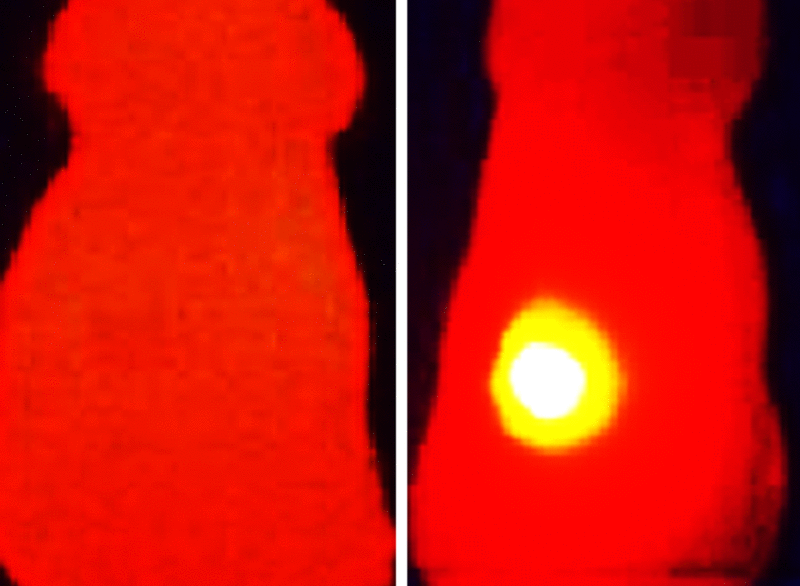Apr 5 2019
Human beings are protected from the harmful rays of the sun by the dark skin pigment melanin, which absorbs light energy and converts it to heat. Due to this, it can be a very effective tool in tumor diagnosis and treatment, as described by a team from the Technical University of Munich (TUM) and Helmholtz Zentrum München.
 Infrared thermal image (right) shows elevated tumor (yellow) temperature in mice after laser irradiation in with OMV-melanin treated mice. The image on the left shows a mouse treated with OMVs without melanin. (Image credit: V. Gujrati/TUM)
Infrared thermal image (right) shows elevated tumor (yellow) temperature in mice after laser irradiation in with OMV-melanin treated mice. The image on the left shows a mouse treated with OMVs without melanin. (Image credit: V. Gujrati/TUM)
The researchers were able to produce nanoparticles derived from melanin-loaded cell membrane, which enhanced tumor imaging in an animal model while also delaying the tumor growth.
Nanoparticles are regarded as a potential weapon in the fight against tumors because they absorb nanoparticles more readily when compared to the healthy cells as their vascular system is more permeable. Outer membrane vesicles (OMVs) represent a good example, which are fundamentally small bubbles surrounded by a bacterial membrane.
These particles with a size of 20 to 200 nm are of interest since they are biodegradable, biocompatible, and can be easily and cheaply produced in bacteria, even in bulk quantities. Once loaded with medicinal active agents, they can be easily administered.
Nanoparticles Carrying a Black Cargo
The great promise of OMVs in tumor diagnosis and treatment has been established by Prof. Vasilis Ntziachristos, Professor of Biological Imaging at TUM, and his team. Their work is based on the characteristic properties of OMVs and melanin.
Melanin absorbs light very readily—even in the infrared spectrum. We use precisely this light in our optoacoustic imaging technique for tumor diagnosis. It simultaneously converts this absorbed energy into heat, which is then emitted. Heat is also a way to combat tumors—other researchers are currently exploring this method in clinical trials.
Dr Vipul Gujrati, Study First Author, TUM.
A technique that has been considerably advanced by Ntziachristos, called optoacoustics, incorporates the advantages of optical imaging and ultrasound technology. The tissue is lightly heated by weak laser pulses, which cause it to temporarily expand very slightly.
As the tissue cools down, it contracts by producing ultrasound signals. Based on the type of tissue, the measured signals vary. The researchers record them using unique detectors and “translate” them into three-dimensional images. The accuracy and specificity of the technique can be enhanced even further by sensor molecules or probes (such as OMVs).
Heat Build-Up Reduces Tumor Growth
Initially, the researchers had to get over an issue specific to melanin: It is difficult to administer as it is not very water-soluble. At this point, the OMVs came into play. The scientists created bacteria in such a way that they synthesize melanin and store it in their membrane-derived nanoparticles. Later, they tested the black nanoparticles in mice that had tumors in their lower back region. The particles were administered directly into the tumor, which was stimulated with infrared laser pulses as part of the optoacoustic method.
OMVs were found to be the perfect sensor probes for this diagnosis method as they offered sharp, high-contrast images of the tumor. In addition, they are compatible with photothermal therapy methods, where the tumor tissue is heated with stronger laser pulses for destroying the cancer cells. The melanin in the nanoparticles led to an increase in the temperature of the tumor tissue from 37 °C to nearly 56 °C.
Control tumors that did not have melanin only reached a highest temperature of 39 °C. Ten days after the treatment, the tumors developed at a considerably slower rate when compared to those in the control group that had not received melanin OMVs. This heat effect was augmented by another constructive effect of the particles: The immune system was activated to attack the tumor by causing a slight non-specific inflammation in the tumor tissue.
Our melanin nanoparticles fit into the new medical field of theranostics—where therapy and diagnostics are combined. This makes them a highly interesting option for use in clinical practice.
Vasilis Ntziachristos, Professor, Biological Imaging, TUM.
Now, the researchers will further develop their OMVs to introduce them into clinical use in the future.